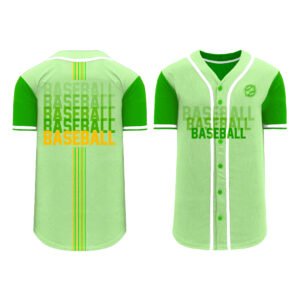How the Baseball Jersey Back Has Evolved Over the Decades
The baseball jersey back has undergone significant transformations since the inception of the sport, reflecting changes in design, technology, and cultural trends. From the early days of the sport to the modern era, the back of a baseball jersey has become a canvas for expression and identity among players and teams alike.


The Origins of Baseball Jerseys
In the late 19th century, baseball uniforms were simple and functional. Early jerseys featured:
- Basic colors, often white or gray.
- No player names or numbers; identification was based on position.
- Material primarily made from cotton or wool, providing little breathability.
During this period, the focus was primarily on practicality rather than aesthetics. Teams wore variations of the same style, making them nearly indistinguishable from one another on the field.
The Introduction of Player Numbers
As the sport gained popularity in the early 20th century, the need for individual identification led to a revolutionary change: the introduction of numbers on the jersey back. This development began around the 1920s, and some key aspects included:
- Player numbers were first used by the New York Yankees in 1929.
- Numbers allowed fans and commentators to easily identify players during games.
- Jersey backs started to serve a functional purpose beyond mere decoration.
This shift set the stage for a long-lasting practice that has become a standard across all sports. The traditional design remained relatively simple, focusing on the number’s visibility for fans and officials alike.
The Personal Touch: Names on the Jersey Back
By the 1960s, another milestone was reached when player names began to appear on the back of jerseys. This transition provided several advantages:
- Enhanced fan engagement by allowing supporters to connect personally with their favorite players.
- Facilitated easier identification of players for fans unfamiliar with the team line-up.
- Helped establish player brand identities within the sport, paving the way for merchandise sales.
The 1970s brought further advancements, such as the introduction of more vibrant team colors and designs, granting teams flexibility in choosing styles that better represented their identities.
Modern-Day Innovations and Trends
In contemporary baseball, jersey backs have embraced a wave of innovation. The modern jersey is not only about aesthetics but also incorporates advanced features like:
- High-performance fabrics that wick away moisture and enhance player comfort.
- Custom designs that allow teams to convey their brand stories and connect with fans.
- Technology-forward designs, such as incorporating RFID chips for fan interaction and embeddable features.
Furthermore, as cultural shifts occur, baseball jerseys are adapting to include more personalized touches, with players opting for unique styles in the choice of font, colors, and number placements. Social media has also played a significant role in showcasing these jerseys, allowing fans worldwide to engage with their favorite players and teams through their fashion choices.
Overall, the evolution of the baseball jersey back signifies more than just fashion; it symbolizes the sport’s growth and transformation over time. Each design choice and innovation reflects the culture surrounding baseball while capturing the spirit of its ever-evolving landscape.
What Makes the Baseball Jersey Back Design Unique
The baseball jersey back design is not just a functional piece of sportswear; it carries a rich narrative steeped in tradition, identity, and the evolving nature of the game itself. From player names to numbers, every element serves a distinct purpose that contributes to the overall aesthetic and spirit of the team. In this section, we will explore what makes the design of the baseball jersey back unique and how it resonates with fans and players alike.
1. Player Identification
One of the most significant aspects of the baseball jersey back design is its capacity for player identification. In a sport where individual contribution is crucial, the player’s name and number help fans, teammates, and coaches easily recognize each player on the field. Key elements include:
- Names: Displaying the player’s last name allows fans to connect with their favorite athletes on a personal level.
- Numbers: A unique number serves as another identifier, often becoming iconic to the player’s career.
- Font Style and Size: The choice of font can reflect a team’s culture, history, and branding.
2. Team Culture and Brand Identity
The baseball jersey back design also plays a vital role in conveying a team’s overall culture and brand identity. The choices that teams make in their jersey designs can have a lasting impact. Considerations include:
- Colors: Team colors are prominently featured, embodying the essence of the franchise and its legacy.
- Logos: Some teams choose to include a small logo on the back, reinforcing brand recognition.
- Historical Significance: Teams often incorporate elements from their history, such as throwback designs that honor past players or eras.
3. Functionality Meets Style
Beyond aesthetics, the baseball jersey back design has evolved for functionality and comfort. Players need to perform at their best, and every aspect of the jersey is designed with that in mind. Important considerations include:
- Material Choice: Modern jerseys are made from lightweight and breathable materials that allow maximum flexibility and sweat-wicking capabilities.
- Number Placement: The placement of the number on the back is designed for visibility, ensuring umpires and fans can see player identities easily during games.
- Comfort Fit: The design allows for a range of body types, allowing for adaptability and comfort during play.
4. Fan Engagement and Merchandise
Finally, the uniqueness of baseball jersey back design extends beyond the field to engage with fans. The back designs often play a significant role in merchandise sales and fandom. Several factors include:
- Replica Jerseys: Fans often buy replica jerseys with player names and numbers, creating a sense of belonging and loyalty to the team.
- Customizations: Fans enjoy the option to customize their jerseys, adding personal touches that enhance their connection to the team.
- Limited Editions: Teams often release limited-edition jerseys featuring special designs on the back, increasing their appeal and value.
In conclusion, the baseball jersey back design packs a powerful punch in terms of identity, culture, functionality, and fan engagement. It is a canvas that tells the story of not just the players, but also the legacy of the teams and their connection to the community. As the game evolves, so too will the designs that grace the backs of these iconic jerseys, continually reflecting the spirit of baseball and its fans.
The Impact of Player Names on the Baseball Jersey Back
The design of baseball jerseys has undergone significant changes since the sport’s inception, and one of the most remarkable aspects is the inclusion of player names on the back. This addition has shifted not only how fans perceive their favorite athletes but also how players view their own identity within the sport. Understanding this impact requires a closer look at its historical context, cultural significance, and practical implications.
Historical Context of Player Names on Jerseys
The tradition of identifying players by name on their jerseys emerged in the late 1970s. Initially, jerseys featured only a player’s number, creating a generic identity that often made it difficult for fans to connect with individual players. As the game grew in popularity, the need for personalized recognition became apparent. Key factors influencing this change included:
- Media Coverage: As television broadcasts became more popular, fans at home wanted to easily recognize players. Names on jerseys facilitated this recognition.
- Marketability: Teams recognized the commercial potential of branding players. Having names on jerseys allowed fans to form unique connections with their favorite athletes.
- Fan Engagement: Personalization fostered a deeper sense of loyalty. Fans were able to invest in particular players rather than just the team as a whole.
Cultural Significance and Fan Connection
The decision to print player names on the back of baseball jerseys transcends mere aesthetics. It plays a vital role in shaping the culture surrounding baseball. Here are some ways player names enhance this connection:
- Identification: Fans often choose jerseys bearing the names of players they admire. This creates a sense of belonging and community as they rally behind familiar figures.
- Personal Stories: Each player’s journey brings a unique narrative to the game. Fans wearing a jersey with a specific name can showcase their admiration for that story, whether it’s a rookie’s rise or a legend’s retirement.
- Emotional Investment: The name on the back of a jersey can evoke strong feelings. A player’s success or failure feels personal, deepening the emotional bond between fans and their teams.
Practical Implications of Named Jerseys
While the emotional and cultural aspects of player names on the jerseys are vital, there are also practical reasons for including them:
- Fan Interactions: At games, it’s much easier to cheer for a specific player by name, enhancing the overall experience for fans and players alike.
- Merchandising: Player-named jerseys are one of the best-selling merchandise items. Teams generate significant revenue from fans purchasing jerseys that bear their favorite player’s name.
- Recognition During Events: Special events, such as All-Star games or Hall of Fame inductions, benefit from clear identification of players, ensuring fans can connect and celebrate the star athletes in attendance.
In conclusion, the inclusion of player names on the back of baseball jerseys has transformed the way fans engage with the game. It acts as a bridge between the athlete’s identity and the communal spirit of the fans, amplifying the emotional connection that lies at the heart of sports. As teams continue to explore new designs and branding strategies, the significance of the player names on the back will undoubtedly remain a cornerstone of this beloved sport.
Exploring the Cultural Significance of the Baseball Jersey Back Design
The design of a baseball jersey is more than just fabric and thread; it is a canvas that tells a story. The back of a baseball jersey, in particular, serves as a focal point for identity, pride, and community. As fans and players alike come together, the baseball jersey back reveals insights into the cultural dynamics that surround America’s favorite pastime.
Identity and Individuality
The back of a baseball jersey is emblazoned with a player’s name and number, offering a direct avenue for personal and professional identity. This representation plays a crucial role in shaping the fan experience:
- Player Recognition: Fans can easily identify their favorite players, creating a sense of familiarity and connection.
- Community Bonds: Wearing a jersey with a player’s name fosters camaraderie among fans, helping to build a community that rallies together during games.
- Cultural Icons: Legendary players’ names on jerseys can elevate them to status of cultural icons, representing not just athletic prowess but broader societal themes such as perseverance and achievement.
Tradition and Heritage
The design elements of a baseball jersey back are often steeped in tradition, capturing the essence of the sport’s rich heritage. From classic designs to modern iterations, the back of a jersey represents a continuum that fans appreciate and honor:
- Classic Fonts: Many teams use traditional fonts reminiscent of historical designs, preserving the spirit of earlier eras while engaging newer generations.
- Team Colors and Styles: The colors and styles chosen reflect the team’s culture and history, embodying the regional pride of their bases.
- Celebration of Milestones: Special jerseys may be produced to commemorate significant milestones, ensuring that fans and players share in unforgettable moments.
The Impact of Technology and Change
As with many aspects of sports, the design of the baseball jersey back has not remained stagnant. Advances in technology and changing cultural landscapes have influenced how these jerseys are designed and perceived:
- Customized Jerseys: The rise of online retail has allowed fans to personalize jerseys, further emphasizing individual expression.
- Innovative Materials: Technological advancements have led to more comfortable, durable fabrics, elevating the status of jerseys as both functional sportswear and fashion statements.
- Designer Collaborations: High-profile partnerships with designers have introduced unique styles that blend athletic wear with contemporary fashion, attracting a wider audience.
Conclusion
The back of a baseball jersey transcends mere functionality. It serves as a vital aspect of cultural expression within the sport. By capturing elements of identity, tradition, and change, the baseball jersey back reflects the evolving narrative of baseball itself. Whether on the field or in the stands, it brings fans together, celebrating not just the game, but the relationships, emotions, and memories that baseball fosters. As we look ahead, it will be fascinating to see how the baseball jersey back continues to shape and reflect the cultural significance of this beloved game.

